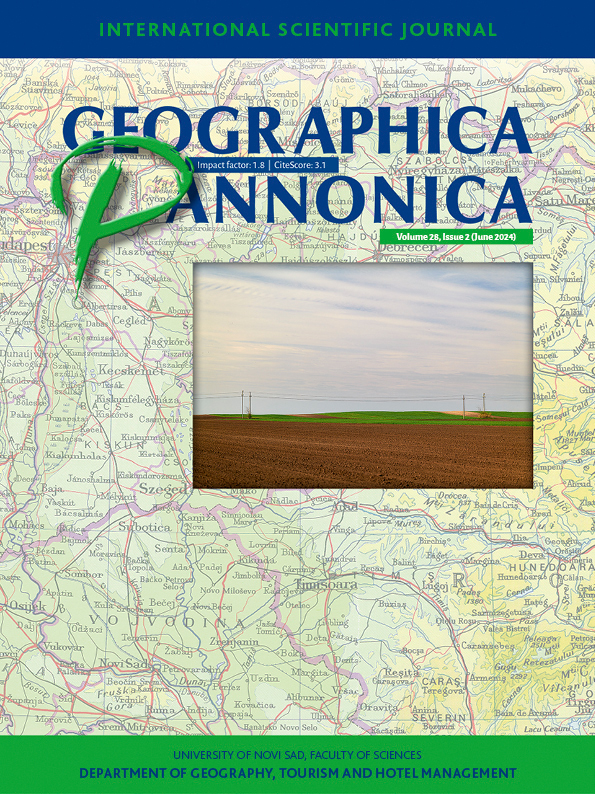The Impact of the Economic and Social Shocks (Crises) of the 2000s on Gross Value Added in Central-Eastern Europe
Abstract
Territorial economic and social disparities remain a major problem for the European Union today, especially in Eastern Europe. The aim of this study is to analyse the impact of the eco- nomic and social shocks of the 2000s (the economic and financial crisis of 2008-09 and the COVID-19 pandemic) on the economies of four Central Eastern European countries (Czech Republic, Slovakia, Poland, Hungary). The study presents county-level differences in gross value added with classical descriptive statistics, inequality indices, convergence analyses and spatial autocorrelation. The results show that the impact of the shocks of the 2000s var- ies across counties, which led to different paths of recovery. Spatial autocorrelation is signif- icant, but patterns remain stable through the period of exogenous shocks.
References
Anselin, L. (2005). Exploring spatial data with GeoDaTM: a workbook. Center for spatially integrated social science. https://www.geos.ed.ac.uk/~gisteac/fspat/geodaworkbook.pdf [10 March 2019]
Arbia, G., Basile, R. & Piras, G. (2005). Using Spatial Panel Data in Modelling Regional Growth and Convergence. ISAE Working Paper, No. 55. Roma: L’Istituto di Studi e Analisi Economica (ISAE). http://dx.doi.org/10.2139/ssrn.936321 [17 December 2023]
Barro, R.J. & Sala-i-Martin, X. (1992). Convergence. Journal of Political Economy, 100(2), 223- 251. http://dx.doi.org/10.1086/261816
Boyle, G.E. & McCarthy, T.G. (1997). Simple measures of convergence in per capita GDP: a note on some further international evidence. Applied Economic Letters, 6(6), 343-347. http://dx.doi.org/10.1080/135048599353041
Dusek, T. (2004): A területi elemzések alapjai. (Basics of spatial analysis.) Regionális tudományi tanulmányok 10. ELTE Regionális Földrajzi Tanszék, MTA-ELTE Regionális Tudományi Kutatócsoport, Budapest, 245 p.
Eckey, H.F. & Türck, M. (2007). Convergence of EU-regions. A Literature Report. Investigaciones Regionales, 10, 5-32.
European Commission (2022). 8th Cohesion report. https://ec.europa.eu/commission/presscorner/api/files/document/print/en/ip_22_762/IP_22_762_EN.pdf. [17 December 2023]
European Investment Bank (2012). The impact of the recession in 2008-2009 on EU regional convergence. https://www.eib.org/attachments/efs/econ_note_2012_regional_convergence_en.pdf. [13 October 2023]
European Parliament (2019). Regional inequalities in the EU. https://www.europarl.europa.eu/RegData/etudes/BRIE/2019/637951/EPRS_BRI(2019)637951_EN.pdf [13 October 2023]
Eurostat (2023a). Regional database 2023. https://ec.europa.eu/eurostat/databrowser/view/nama_10r_3gdp/default/table?lang=en [05 January 2023]
Eurostat (2023b). Annual national accounts, metadata. https://ec.europa.eu/eurostat/cache/metadata/en/nama10_esms.htm [05 January 2023]
Ferkelt, B. (2005). Konvergencia az eurozónában a közös pénz bevezetése előtt és után. (Convergence in the euro area before and after the introduction of the single currency) EU working papers, 4, 3-15.
Gerkman, L. & Ahlgren, N. (2011). Practical Proposals for Specifying k-Nearest Neighbours Weights Matrices. Hanken School of Economics, Working Papers 555.; 29 p.
Gorzelak, G. (2020). The eastern horizon – A regional perspective. European Investment Bank, ISBN: 978-92-861-4726-5.
Henderson, V. & Thisse, J.F. (2004). Handbook of Regional and Urban Economics: Cities and Geography. Elsevier.
Iammarino, S., Rodríguez-Pose, A. & Storper, M. (2019). Regional inequality in Europe: evidence, theory and policy implications. Journal of Economic Geography, 19(2). 273-298. http://dx.doi.org/10.1093/jeg/lby021
Kocziszky, Gy. & Szendi, D. (2020). Additions for ex-post and ex-ante modelling of regional development paths. In: Z. Gál, S.Zs. Kovács, B. Páger (eds.) Flows of Resources in the Regional Economy in the Age of Digitalisation: Proceedings of the 7th CERS Conference. 11-20.
Mankiw, N.G., Romer, D., & Weil, D.N. (1992). A contribution to the empirics of economic growth. The Quarterly Journal of Economics, 107(2), 407–437. https://doi.org/10.2307/2118477
Nagyné Molnár, M. (2007). A területi egyenlőtlenségek főbb összefüggései. (Main contexts of territorial disparities), In: Regionális gazdaságtan. J. Káposzta (ed.), DE Kiadó, Debrecen, 166-205.
Nemes Nagy, J. (1990). Területi egyenlőtlenségek dimenziói. (Dimensions of territorial disparities) Tér és Társadalom, 4(2), 15-30.
OECD (2016). Indexes and estimation techniques, in OECD Regions at a Glance 2016. OECD Publishing, Paris. https://doi.org/10.1787/reg_glance-2016-50-en
OECD (2020). COVID-19 crisis highlights widening regional disparities in healthcare and the economy. https://www.oecd.org/newsroom/covid-19-crisis-highlights-widening-regional-disparities-in-healthcare-and-the-economy.htm. [17 December 2023]
Palomino, J.C., Rodríguez, J.G. & Sebastian, R. (2020). Wage Inequality and Poverty Effects of Lockdown and Social Distancing in Europe. European Economic Review, 129, 103564. 1. https://doi.org/10.1016/j.euroecorev.2020.103564
Quah, D.T. (1996). Empirics for economic growth and convergence. European Economic Review, 40, 1353-1375. http://dx.doi.org/10.1016/0014-2921(95)00051-8
Sala-i-Martin, X. (1995). The Classical Approach to Convergence Analysis. Economics Working Papers 117, Department of Economics and Business, Universitat Pompeu Fabra, 18 p.
Soós, E. (2020). Regionális politika az Európai Unióban. (Regional policy in the European Union) Szegedi Tudományegyetemen. http://eta.bibl.u-szeged.hu/4862/12/OLVAS%C3%93LECKE%202.pdf [05 January 2023]
Strauss-Khan, M. O. (2020). Can we compare the COVID-19 and 2008 crises? Atlantic Council. https://www.atlanticcouncil.org/blogs/new-atlanticist/can-we-compare-the-covid-19-and-2008-crises/ [08 March 2023]
Szendi, D. (2016). Perifériák felzárkózásának esélyei, különös tekintettel a Kelet-Közép-Európa két térségére. (The catching-up of peripheral regions, with special regards on two regions from Central and Eastern Europe. PhD dissertation) Doktori disszertáció, Miskolci Egyetem, 227. p.
Tobler, W.R. (1970). A Computer Movie Simulating Urban Growth in the Detroit Region. Economic Geography, 46, 234-40.
Tóth, G., Jáger, V., Kovalszky, Z., Bóday, P., Ádám, D., & Kincses, Á. (2023). A magyarországi háztartások energiafogyasztásának jellemzői az orosz–ukrán háború árnyékában = Characteristics of Hungarian households’ energy consumption in the shadow of the Russian-Ukrainian war. STATISZTIKAI SZEMLE, 101(2), 118–144. http://doi.org/10.20311/stat2023.02.hu0118
Varga, A. (2002). Térökonometria. (Spatial econometrics.) Statisztikai szemle, 80(4), 354–370.

